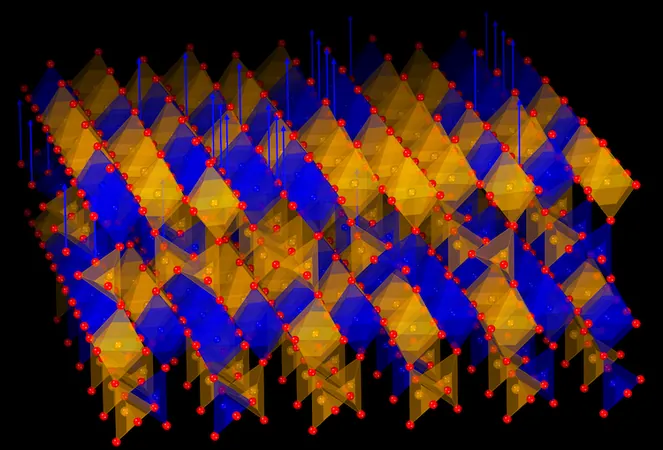
Meet the Revolutionary 'Breathing' Crystal That Could Transform Energy Storage!
2025-09-09
Author: Siti
A Groundbreaking Discovery: The Breathing Crystal
Scientists have unveiled a remarkable new crystal that has the ability to absorb and release oxygen in a reversible manner, paving the way for exciting innovations in clean energy technology. This 'breathing' crystal, crafted from strontium, cobalt, and iron, shows incredible potential for applications in fuel cells, smart windows, thermal transistors, and cutting-edge batteries.
Unleashing the Power of Transition-Metal Oxides
Transition-metal oxides are celebrated for their diverse electrical properties, with capabilities ranging from insulation to superconductivity. This versatility makes them invaluable across various fields, including energy storage, catalysis, and electronics. A key factor in unlocking their potential lies in the manipulation of oxygen vacancies, which can create new structural phases for advanced oxygen-driven programmable devices.
Element-Specific Innovations
Leading a research team, physicist Hyoungjeen Jeen from Pusan National University and materials scientist Hiromichi Ohta from Hokkaido University focused on SrFe0.5Co0.5Ox. Their work sheds light on the catalytic activity of specific ions within the compound, overcoming challenges faced by previous cobalt-containing oxides that were prone to damage during chemical reactions.
A Breath of Fresh Air: How the Crystal Works
Using an innovative pulsed laser deposition technique, the researchers synthesized a unique solid solution in which cobalt and iron ions existed in a shared chemical environment. This arrangement is crucial, as it enables the crystal to effectively release and absorb oxygen. Jeen likens it to giving the crystal 'lungs' that allows it to 'inhale' and 'exhale' oxygen on command.
Stability Meets Efficiency
The ability to control oxygen flow stems from the distinct catalytic actions of cobalt and iron within the compound. Cobalt is adept at oxygen exchange, serving as the main site for redox activities, while iron contributes structural integrity. This duality ensures that the process remains stable and repeatable under ambient conditions, without the fragility or high-temperature limitations of other materials.
A Bright Future for Smart Materials
Remarkably, the newly developed material can revert to its original structure once oxygen is reintroduced, confirming its fully reversible capabilities. Jeen believes this breakthrough is a significant leap toward creating smart materials that can adapt in real-time. Potential applications include advanced cathodes for solid oxide fuel cells, devices that control heat flow like electrical switches, dynamic smart windows, and pioneering battery designs.
What's Next?
Looking ahead, the team led by Jeen and Ohta is eager to explore further practical applications for this innovative material, positioning it as a game-changer in the sustainable energy landscape.

 Brasil (PT)
Brasil (PT)
 Canada (EN)
Canada (EN)
 Chile (ES)
Chile (ES)
 Česko (CS)
Česko (CS)
 대한민국 (KO)
대한민국 (KO)
 España (ES)
España (ES)
 France (FR)
France (FR)
 Hong Kong (EN)
Hong Kong (EN)
 Italia (IT)
Italia (IT)
 日本 (JA)
日本 (JA)
 Magyarország (HU)
Magyarország (HU)
 Norge (NO)
Norge (NO)
 Polska (PL)
Polska (PL)
 Schweiz (DE)
Schweiz (DE)
 Singapore (EN)
Singapore (EN)
 Sverige (SV)
Sverige (SV)
 Suomi (FI)
Suomi (FI)
 Türkiye (TR)
Türkiye (TR)
 الإمارات العربية المتحدة (AR)
الإمارات العربية المتحدة (AR)